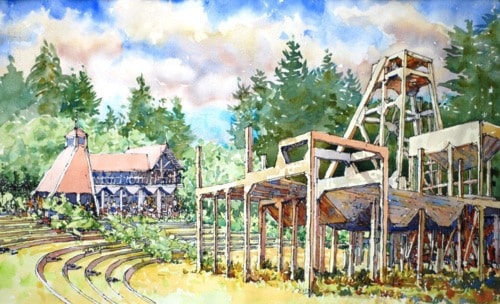If the B.C. government wants to save the key components to Morden Colliery Provincial Historic Park, it has a short window of opportunity.
That’s one message a Friends of Morden Mine Society delegation is pitching to Terry Lake, environment minister, Monday (May 7) in Victoria.
Another is that government does not have to do it alone.
The delegation, including society directors Eric Ricker, John Knappett and John Hofman, and Parksville-Qualicum Liberal MLA Ron Cantelon, hope to convince Lake of the urgency to repair Morden’s headframe and tipple, and discuss future development of the park.
Acquired as a park in 1972, the Morden site features one of only two remaining coal mining headframes and tipples in North America. The other is in Muddy, Ill.
Site preparation of the Morden mine began 100 years ago and construction of the headframe started in 1913.
“They decided to go with, for the times, a fancy way of building the headframe,” said Ricker. “The shaft at Morden was 600 feet, the deepest on Vancouver Island. That’s probably another reason they took the trouble to build such a sturdy rig to run the elevators.”
After falling into a state of disrepair following the collapse of the coal mining industry, the property became a park thanks to the efforts of George Wilkinson, whose father was the inspector of mines in that area.
“He had friends in the government and started writing letters pointing out this was the only intact mine left on Vancouver Island and should be saved,” said Ricker. “The response was swift and the government acquired the land.”
But little was done to develop the park since then and erosion over the years has put the headframe at risk.
“Wood beams within the concrete headframe collapsed about five years ago, and if you look at the site every year, you can see the growth of the rebar exposure as the concrete is peeled off by weathering,” said Ricker. “It’s a clear sign things aren’t good.”
Hofman, an engineer, echoed Ricker's concern about the headframe, convinced it's not if, but when the remaining wood beams will collapse.
"Who knows what they will demolish on their way down?" he said. "Some of the vertical columns are splitting and if one of those goes, the whole structure could collapse.
Hofman is disappointed to see the headframe deteriorating and with it, part of Nanaimo's history.
"This is on public property and we should be able to do something about it," he said. "Mining was an enormous industry from Nanoose to Chase River and we have very little evidence left."
Ricker admits times are tough to be asking for money, as many parks need an infusion of cash.
“B.C. Parks doesn’t have any budget. It has been slashed back for years under all governments,” he said. “But structures like this don’t wait for better budgetary years. They have to be accounted to or they’re gone.”
Ricker hopes to convince the government there’s tremendous potential in the site.
“That is one thing we will be emphasizing to the minister,” he said. “It’s not just an old coal mine, it’s much more.
“This could be the hub for the south Nanaimo area as a tourist, education and recreation area
The society had two engineering reports done on the site, both indicating the structure could be saved, but also pointing out serious problems that must be addressed.
Knappett, whose company worked on the Kinsol Trestle restoration project in the Cowichan Valley, toured the site with Hofman and provided ideas on how to tackle the project and how much emergency repairs might cost.
“This is a situation where realistically people who go into fix it are not going to find what they’re hoping for and you get into the possibility of escalating costs,” he said. “I can say the long-term fix is estimated at $2 million.”
If the government commits to emergency repairs, the society is willing to fundraise the $2 million to turn the park into an interpretive centre where people can learn about the industry, as well as memorialize the miners of Vancouver Island who toiled in it.
“We know the park system is deprived all over and it’s not one government’s fault, but a useful approach to amend that kind of deficit is to work with community groups,” said Ricker. “If people really want the parks the governments have provided, they should be prepared to rally round and help make them work properly.
“In our case, we’re saying fix the structure, and we’ll try and do as much of the rest as we can.”
The society doesn’t have a timeframe for building the interpretation centre, but is clear on emergency repairs to the structure.
”Immediately,” said Ricker. “Every year that passes means the costs go up. In our view, if the government wants this park saved, the repair job has to be done.”
The delegation has letters of support from the City of Nanaimo, Regional District of Nanaimo, Town of Ladysmith and NDP MLAs Leonard Krog and Doug Routley.
“We have a good message, a good site plan and within all the circles where the decisions are made, there’s general awareness of the situation,” said Ricker. “Something like this is never anyone’s top priority, but it can’t wait for better economic times.
“If it’s a case of establishing priorities and people have indicated they are willing to put money into developing or repairing parks, then the government should be matching their efforts in some fashion.”
